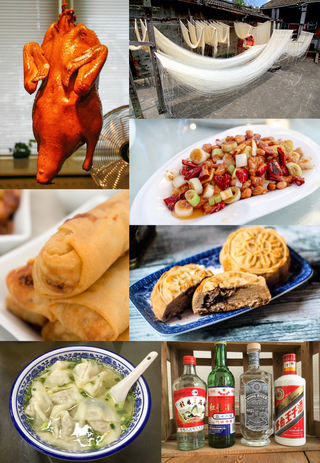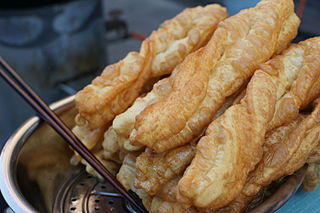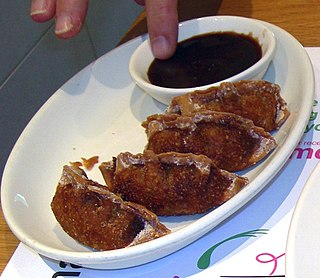Related Research Articles

Teochew cuisine, also known as Chiuchow cuisine, Chaozhou cuisine or Teo-swa cuisine, originated from the Chaoshan region in the eastern part of China's Guangdong Province, which includes the cities of Chaozhou, Shantou and Jieyang. Teochew cuisine bears more similarities to that of Fujian cuisine, particularly Southern Min cuisine, due to the similarity of Teochew's and Fujian's culture, language, and their geographic proximity to each other. However, Teochew cuisine is also influenced by Cantonese cuisine in its style and technique.

Chinese cuisine comprises cuisines originating from China, as well as from Chinese people from other parts of the world. Because of the Chinese diaspora and the historical power of the country, Chinese cuisine has profoundly influenced many other cuisines in Asia and beyond, with modifications made to cater to local palates. Chinese food staples such as rice, soy sauce, noodles, tea, chili oil, and tofu, and utensils such as chopsticks and the wok, can now be found worldwide.

Soy sauce is a liquid condiment of Chinese origin, traditionally made from a fermented paste of soybeans, roasted grain, brine, and Aspergillus oryzae or Aspergillus sojae molds. It is recognized for its saltiness and pronounced umami taste.

The soybean, soy bean, or soya bean is a species of legume native to East Asia, widely grown for its edible bean, which has numerous uses.

Seitan is a food made from gluten, the main protein of wheat. It is also known as miànjīn, fu, milgogi, wheat meat, gluten meat, or simply gluten.

Youtiao, known in Southern China as Yu Char Kway, is a long golden-brown deep-fried strip of wheat flour dough of Chinese origin and also popular in other East and Southeast Asian cuisines.

Douhua is a Chinese sweet or savoury snack made with silken tofu. It is also referred to as doufuhua, tofu pudding, soybean pudding or, particularly in northern China, tofu brains.

Douchi is a type of fermented and salted black soybean most popular in the cuisine of China, where they are most widely used for making black bean sauce dishes.

Chinese Indonesian cuisine is characterized by the mixture of Chinese with local Indonesian style. Chinese Indonesians, mostly descendant of Han ethnic Hokkien and Hakka speakers, brought their legacy of Chinese cuisine, and modified some of the dishes with the addition of Indonesian ingredients, such as kecap manis, palm sugar, peanut sauce, chili, santan and local spices to form a hybrid Chinese-Indonesian cuisine. Some of the dishes and cakes share the same style as in Malaysia and Singapore, known as Nyonya cuisine by the Peranakan.

Claypot rice, sometimes translated as "rice casserole", is a Chinese traditional dinner eaten widely in Guangdong in Southern China as well as the Chinese communities of Malaysia, Indonesia, Singapore and Thailand.

A rice noodle roll, also known as a steamed rice roll and cheung fun, and as look funn or look fun in Hawaii, is a Cantonese dish originating from Guangdong Province in southern China, commonly served as either a snack, small meal or variety of dim sum. It is a thin roll made from a wide strip of shahe fen, filled with shrimp, beef, vegetables, or other ingredients. Seasoned soy sauce – sometimes with siu mei drippings – is poured over the dish upon serving. When plain and made without filling, the rice noodle is also known as jyu cheung fun, literally "pork intestine noodle", a reference to its resemblance of a pig's intestines. There is no official recording of the history of rice noodle rolls; most cookbooks claim that it was first made in the 1930s. In Guangzhou, Guangdong Province, people called the dish laai cheung because it is a noodle roll that pulled by hand.

Japanese Chinese cuisine, also known as chūka, represents a unique fusion of Japanese and Chinese culinary traditions that have evolved over the late 19th century and more recent times. This style, served predominantly by Chinese restaurants in Japan, stands distinct from the "authentic Chinese food" found in areas such as Yokohama Chinatown. Despite this difference, the cuisine retains strong influences from various Chinese culinary styles, as seen in the shippoku cooking style.

Tương is the name applied to a variety of condiments, a kind of fermented bean paste made from soybean and commonly used in Vietnamese cuisine.
Soy refers to soybean, a species of legume native to East Asia (soya).

Tofu is a food prepared by coagulating soy milk and then pressing the resulting curds into solid white blocks of varying softness: silken, soft, firm, extra firm. Tofu is also known as bean curd in English. Tofu originated in China and has been consumed in the country for over 2,000 years. Tofu is a traditional component of many East Asian and Southeast Asian cuisines. In modern Western cooking, it is often used as a meat substitute.

Hoisin sauce is a thick, fragrant sauce commonly used in Cantonese cuisine as a glaze for meat, an addition to stir fry, or as dipping sauce. It is dark-coloured, sweet and salty. Although regional variants exist, hoisin sauce usually includes soybeans, fennel, red chili peppers, and garlic. Vinegar, five-spice powder, and sugar are also commonly added.
References
- "Breve diccionario etimológico de la lengua española" by Guido Gómez de Silva ( ISBN 968-16-2812-8)